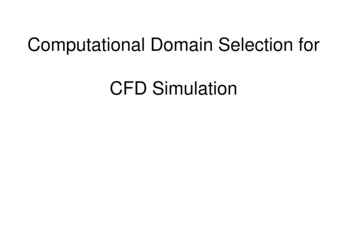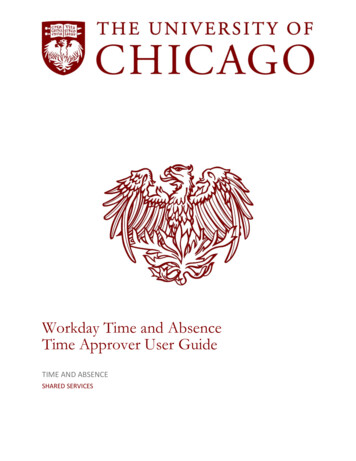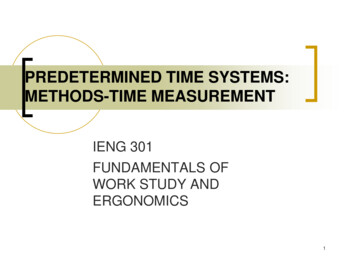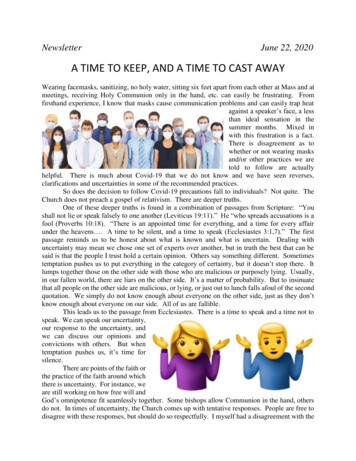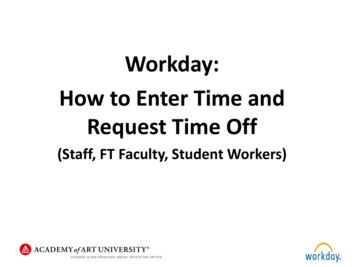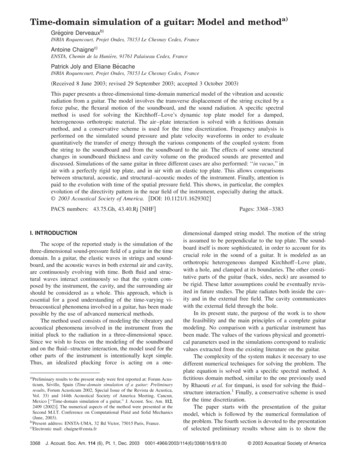
Transcription
Time-domain simulation of a guitar: Model and methoda)Grégoire Derveauxb)INRIA Roquencourt, Projet Ondes, 78153 Le Chesnay Cedex, FranceAntoine Chaignec)ENSTA, Chemin de la Hunière, 91761 Palaiseau Cedex, FrancePatrick Joly and Eliane BécacheINRIA Roquencourt, Projet Ondes, 78153 Le Chesnay Cedex, France共Received 8 June 2003; revised 29 September 2003; accepted 3 October 2003兲This paper presents a three-dimensional time-domain numerical model of the vibration and acousticradiation from a guitar. The model involves the transverse displacement of the string excited by aforce pulse, the flexural motion of the soundboard, and the sound radiation. A specific spectralmethod is used for solving the Kirchhoff–Love’s dynamic top plate model for a damped,heterogeneous orthotropic material. The air–plate interaction is solved with a fictitious domainmethod, and a conservative scheme is used for the time discretization. Frequency analysis isperformed on the simulated sound pressure and plate velocity waveforms in order to evaluatequantitatively the transfer of energy through the various components of the coupled system: fromthe string to the soundboard and from the soundboard to the air. The effects of some structuralchanges in soundboard thickness and cavity volume on the produced sounds are presented anddiscussed. Simulations of the same guitar in three different cases are also performed: ‘‘in vacuo,’’ inair with a perfectly rigid top plate, and in air with an elastic top plate. This allows comparisonsbetween structural, acoustic, and structural–acoustic modes of the instrument. Finally, attention ispaid to the evolution with time of the spatial pressure field. This shows, in particular, the complexevolution of the directivity pattern in the near field of the instrument, especially during the attack. 2003 Acoustical Society of America. 关DOI: 10.1121/1.1629302兴PACS numbers: 43.75.Gh, 43.40.Rj 关NHF兴I. INTRODUCTIONThe scope of the reported study is the simulation of thethree-dimensional sound-pressure field of a guitar in the timedomain. In a guitar, the elastic waves in strings and soundboard, and the acoustic waves in both external air and cavity,are continuously evolving with time. Both fluid and structural waves interact continuously so that the system composed by the instrument, the cavity, and the surrounding airshould be considered as a whole. This approach, which isessential for a good understanding of the time-varying vibroacoustical phenomena involved in a guitar, has been madepossible by the use of advanced numerical methods.The method used consists of modeling the vibratory andacoustical phenomena involved in the instrument from theinitial pluck to the radiation in a three-dimensional space.Since we wish to focus on the modeling of the soundboardand on the fluid–structure interaction, the model used for theother parts of the instrument is intentionally kept simple.Thus, an idealized plucking force is acting on a onea兲Preliminary results to the present study were first reported at: Forum Acusticum, Séville, Spain 共Time-domain simulation of a guitar: Preliminaryresults, Forum Acusticum 2002, Special Issue of the Revista de Acustica,Vol. 33兲 and 144th Acoustical Society of America Meeting, Cancun,Mexico 关‘‘Time-domain simulation of a guitar,’’ J. Acoust. Soc. Am. 112,2409 共2002兲兴. The numerical aspects of the method were presented at theSecond M.I.T. Conference on Computational Fluid and Solid Mechanics共June, 2003兲.b兲Present address: ENSTA-UMA, 32 Bd Victor, 75015 Paris, France.c兲Electronic mail: chaigne@ensta.fr3368J. Acoust. Soc. Am. 114 (6), Pt. 1, Dec. 2003Pages: 3368 –3383dimensional damped string model. The motion of the stringis assumed to be perpendicular to the top plate. The soundboard itself is more sophisticated, in order to account for itscrucial role in the sound of a guitar. It is modeled as anorthotropic heterogeneous damped Kirchhoff–Love plate,with a hole, and clamped at its boundaries. The other constitutive parts of the guitar 共back, sides, neck兲 are assumed tobe rigid. These latter assumptions could be eventually revisited in future studies. The plate radiates both inside the cavity and in the external free field. The cavity communicateswith the external field through the hole.In its present state, the purpose of the work is to showthe feasibility and the main principles of a complete guitarmodeling. No comparison with a particular instrument hasbeen made. The values of the various physical and geometrical parameters used in the simulations correspond to realisticvalues extracted from the existing literature on the guitar.The complexity of the system makes it necessary to usedifferent numerical techniques for solving the problem. Theplate equation is solved with a specific spectral method. Afictitious domain method, similar to the one previously usedby Rhaouti et al. for timpani, is used for solving the fluid–structure interaction.1 Finally, a conservative scheme is usedfor the time discretization.The paper starts with the presentation of the guitarmodel, which is followed by the numerical formulation ofthe problem. The fourth section is devoted to the presentationof selected preliminary results whose aim is to show the0001-4966/2003/114(6)/3368/16/ 19.00 2003 Acoustical Society of America
top plate of the instrument and is the rest of the surface共i.e., sides and back兲. The boundary of itself is divided intotwo parts: 0 is the outer boundary of the top plate and f isthe inner boundary, along the hole. The surrounding air occupies the domain R3 . corresponds to the internalcavity and the external domain, which communicate via thesound hole. The string of length l s is rigidly fixed to the neckat a point denoted O, chosen as the origin of the coordinatesystem 共see Fig. 1兲.B. The stringFIG. 1. Geometrical description of the guitar.main attributes of the method. The detailed presentation ofthe application of the model to important features in the context of guitar acoustics, such as sound power and efficiency,is left for future studies.With regard to previous work on guitars, one can summarize the originality of the present work as follows: First,the cavity model and the air–structural coupling is more general than in the boundary element method, developed by Richardson et al.2 It is also a step forward compared to thespatial Fourier method developed by Le Pichon et al., wherethe velocity distribution on the surface of the body was measured, and not calculated.3 Second, the results obtained in thetime domain with the present model should be compared tothe results obtained in the frequency domain by Elejabarrietaet al., who used commercial software.4 In particular, thebracing used in our model is less accurate than in this latterpaper. However, more emphasis is put here on the description of the air sound field and on the effects of the pressurejump on the top plate.Finally, as far as the numerical technique is concerned,the present modeling is a direct extension to plates of thetimpani model developed by Rhaouti et al.1 The modeling ofdamping in the guitar top plate makes use also of resultsobtained by Chaigne and Lambourg.5II. PRESENTATION OF THE MODELA. DescriptionThe body of the guitar is delimited by a surface denoted which is divided into two parts: 艛 , where is theThe string is supposed to have uniform density s , uniform tension T, and no stiffness. In the following, only thevertical flexural motion of the soundboard will be considered. Therefore, it is also natural to consider only the verticalpolarization of the string. The motion of the string is thusdescribed by its transverse displacement 共perpendicular tothe soundboard兲 denoted u s (x,t), x苸]0,l s 关 . Assuming thatthe amplitudes of vibration are sufficiently small, the stringequation is a classical 1D damped wave equation s冉冊 2u s 2u s us f s 共 x,t 兲 , in ]0,l s 关 . sR s2 T 1 s t t x2 t共1兲The internal damping is modeled by two terms: a viscoelasticterm with coefficient s whose essential purpose is to introduce a frequency-dependent damping in the string, and afluid term with coefficient R s whose purpose is to introducea constant internal damping for low frequencies. The string isfixed at one end to the neck of the guitar, which is supposedto be perfectly rigidu s 共 0,t 兲 0,᭙t 0.共2兲At the bridge, the displacement of the string is assumedto be given by the displacement of the plate at the contactpoint between string and bridge, denoted (x 0 ,y 0 )u s 共 l s ,t 兲 u p 共 x 0 ,y 0 ,t 兲 , ᭙t 0.共3兲The plucking of the string is assumed to be an imposedforce 共see Fig. 2 and Table I兲f s 共 x,t 兲 g 共 x 兲 h 共 t 兲 ,共4兲where h(t) represents a simple idealized version of the‘‘stick–slip’’ mechanism that governs the interaction between string and finger. One pulls on the string during nearlyFIG. 2. Representation of the idealized plucking force. 共a兲 Time dependence. 共b兲 Space dependence.J. Acoust. Soc. Am., Vol. 114, No. 6, Pt. 1, Dec. 2003Derveaux et al.: Time-domain simulation of a guitar3369
TABLE I. Typical values of physical and numerical values used for the simulations. s 0.005 25 kg m 1 ,R s 0.75 s 1 ,String:l s 0.65 m,(x 0 ,y 0 ) (65 cm,4 cm)T 60 N, s 9 10 8 ��D3共MPa兲D4共MPa兲 p共kg m 1兲a共mm兲Rp共s 1兲 70.0050.0050.005共s兲Air: c a 344 m s 1 , a 1.21 kg m 3Numerical information:String:Plate:Pressure jump:Acoustic field:Time step:Sampling frequency:再Plucking force: f s (x,t) g(x)h(t).g共x兲 exp共 共x x0 / s兲2兲lx 0 55 cm, c 0.006 m, t 1 0.015 s, t 2 0.000 4 s.C. The soundboardIt is assumed that the only vibrating part of the guitar isthe soundboard. The other parts of the guitar body 共back,sides, neck兲 are assumed to be perfectly rigid. If necessary,the motion of the back could be introduced straightaway inthis model since it is of exactly the same nature as the topplate. The soundboard is a thin, orthotropic wooden layer,with a soundhole. The thickness is relatively small 共about 3mm兲 compared to the dimensions of the soundboard 共about50 cm long兲. In terms of spectral content, our study is limitedto the bandwidth 0–3000 Hz. For both these reasons, it is notnecessary to use a thick plate model, such as the Reissner–Mindlin one. The flexural Kirchhoff–Love’s plate model isthus appropriate to describe the vibrations of the soundboard.The strutting system and the bridge are considered asheterogeneities of the soundboard. As a consequence, thefollowing physical parameters which characterize the topplate are variable functions of space: density p (x,y), thickness a(x,y), and rigidity tensor for orthotropic materialC(x,y). In what follows, the space dependence of these parameters will be omitted, in order to simplify the notations.Finally, the in-plane motion of the soundboard is neglected compared to its flexural motion. The motion of thestrutted soundboard is thus completely described by thetransverse displacement of the top plate, denoted u p (x,y,t),(x,y)苸 . This motion is governed by the followingequation:7–103370J. Acoust. Soc. Am., Vol. 114, No. 6, Pt. 1, Dec. 2003共1 cos共 t/t1兲兲,0 t t1 ,h共t兲 共1 cos共 共t t1兲/t2兲兲,兰0s exp共 共x x0 / s兲2兲15 ms and releases it during 0.4 ms. This force is distributedover a small segment of the string by means of the smoothlpositive function g, normalized so that 兰 0s g(x)dx 1. Despite its simplicity, this excitation is in fairly good agreementwith experiments.6h c 2.1 mmh p 1.2 cmh 1.2 cmh a 1.1 cm308 nodes3230 nodes1260 nodes 400 000 cubes t 2.10 5 sf e 50 000 Hza p0,t1 t t2 ,t t 2 .冉冊 2u p up 1 p div Div a 3 C 共 ⵜគ u p 兲 a p R p t2 t t F 关 p 兴 ,in ,共5兲where Div is the divergence operator for tensors: (Div. ) j i j , is the plane linearized strain tensor 关 ( គ ) 12 ( ) 兴 , div and ⵜគ denote the usual divergenceoperator and gradient operator for vectors, respectively 共seeAppendix A for details and more explicit notations兲.As for the string, the internal damping in the plate ismodeled by two terms: a viscoelastic term with coefficient p and a fluid term with coefficient R p . Notice, however,that since a spectral method is used for the numerical resolution of this equation, it becomes possible to introduce otherlaws of damping, which do not need to have so simple acounterpart in the time domain. This point will be developedin Sec. III C.The top plate is clamped on 0u p 0 and n u p 0,on 0 ,共6兲whereas the boundary is free along the hole f 共see Appendix A for explicit notations in particular cases兲 nគ 兲 nគ 0,共Mon f , 兲 nគ 关共 M nគ 兲 គ 兴 0,共 DivMon f ,共7兲where M a 3 C (ⵜគ u p ) is the bending moment. nគ denotesthe outer normal and គ the tangential vector along the boundary f . The two conditions in Eq. 共7兲 express approximatelythat force and moment vanish at the free boundary.The force density term exerted on the plate by the surrounding air is 关 p 兴 , the pressure jump across the soundboard. F denotes the force density exerted by the string onthe bridge. It is assumed to be the normal component of theDerveaux et al.: Time-domain simulation of a guitar
tension of the string at this point. This force is applied at thecontact point (x 0 ,y 0 ) between string and bridgeF共 x,y,t 兲 T x u s 共 l s ,t 兲 x 0 ,y 0 共 x,y 兲 .共8兲In addition to its physical meaning, this property guarantees the wellposedness of the continuous model and willbe exploited for ensuring the stability of the numericalscheme, as it will be shown in the next section.D. The acoustic fieldThe acoustic field is governed by the linearized Euler’sequations p c 2a a div共 vᠪ a 兲 t a vᠪ a ⵜគp tin ,共9a兲in ,共9b兲where c a is the speed of the sound in air, a is the density ofair, p is the sound pressure in , and vᠪ a the acoustic velocityin . These equations are complemented by a condition ofcontinuity for the normal componen
This paper presents a three-dimensional time-domain numerical model of the vibration and acoustic radiation from a guitar. The model involves the transverse displacement of the string excited by a force pulse, the flexural motion of the soundboard, and the sound radiation. A specific spectral method is used for solving the Kirchhoff–Love’s dynamic top plate model for a damped .
